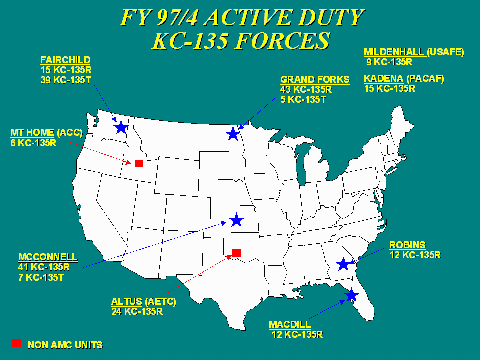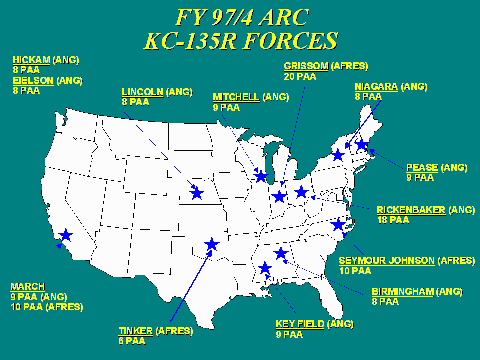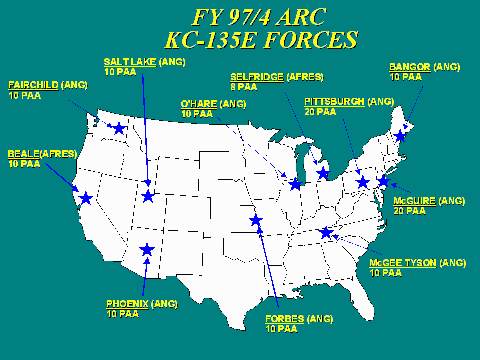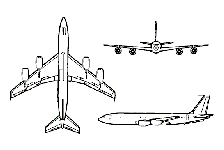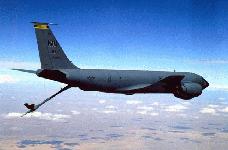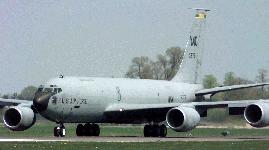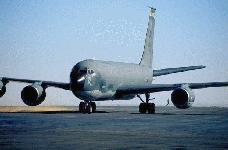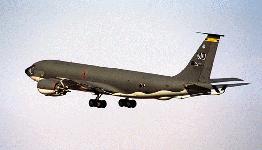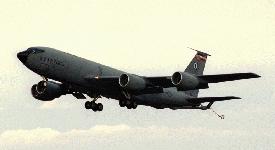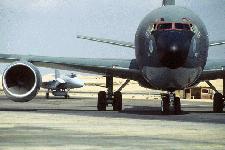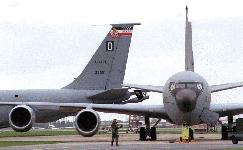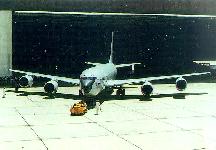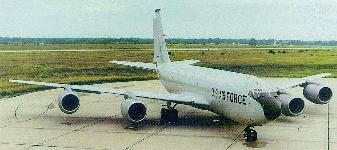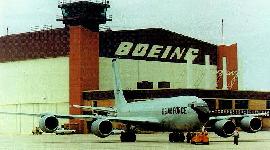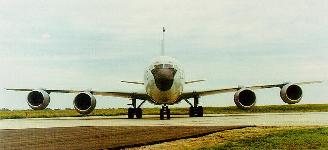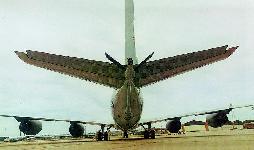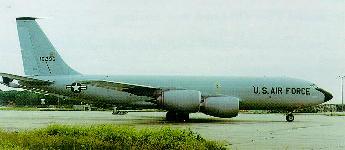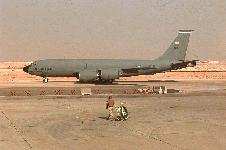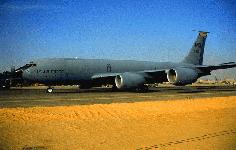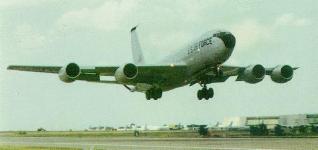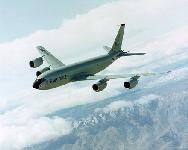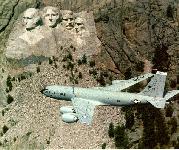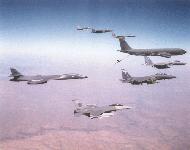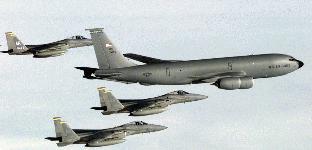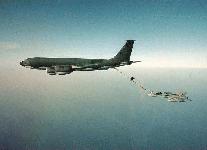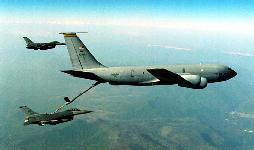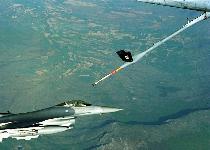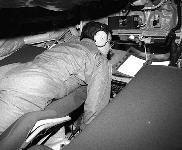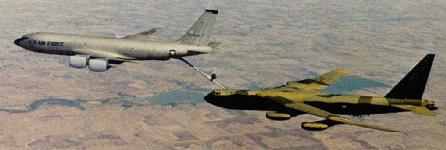





The KC-135 Stratotanker's primary mission is to refuel long-range bombers. It also provides aerial refueling support to Air Force, Navy, Marine Corps and allied aircraft.
Four turbojets, mounted under wings swept 35 degrees, power the KC-135. Nearly all internal fuel can be pumped through the tanker's flying boom, the KC-135's primary fuel transfer method. A special shuttlecock-shaped drogue, attached to and trailed behind the flying boom, is used to refuel aircraft fitted with probes. An operator stationed in the rear of the plane controls the boom. A cargo deck above the refueling system holds passengers or cargo. Depending on fuel storage configuration, the KC-135 can carry up to 83,000 pounds (37,350 kilograms) of cargo.
The KC-135 tanker fleet made an invaluable contribution to the success of Operation Desert Storm in the Persian Gulf, flying around-the-clock missions to maintain operability of allied warplanes. The KC-135s form the backbone of the Air Force tanker fleet, meeting the aerial refueling requirements of bomber, fighter, cargo and reconnaissance forces, as well as the needs of the Navy, Marines and allied nations.
Because the KC-135A's original engines are of 1950s technology, they don't meet modern standards of increased fuel efficiency, reduced pollution and reduced noise levels. By installing new, CFM56 engines, performance is enhanced and fuel off-load capability is dramatically improved. In fact, the modification is so successful that two-re-engined KC-135Rs can do the work of three KC-135As.
This improvement is a result of the KC-135R's lower fuel consumption and increased performance which allow the tanker to take off with more fuel and carry it farther. Since the airplane can carry more fuel and burn less of it during a mission, it's possible to transfer a much greater amount to receiver aircraft.
The quieter, more fuel-efficient CFM56 engines are manufactured by CFM International, a company jointly owned by SNECMA of France, and General Electric of the U.S. The engine is an advanced-technology, high- bypass turbofan; the military designation is F108-CF-100. Related system improvements are incorporated to improve the modified airplane's ability to carry out its mission, while decreasing overall maintenance and operation costs. The modified airplane is designated a KC-135R.
Because the KC-135R uses as much as 27 percent less fuel than the KC-135A, the USAF can expect huge fuel savings by re-engining its fleet of KC-135s - about $1.7 billion over 15 years of operation. That's enough to fill the gas tanks of some 7.7 million American cars each year for a decade and a half. Annual savings are estimated to be about 2.3 to 3.2 million barrels of fuel, about three to four percent of the USAF's annual fuel use. This equals the fuel needed to provide electrical power for 145 days to a city of 350,000 to 400,000.
Re-engining with the CFM56 engines also results in significant noise reductions. Area surrounding airports exposed to decibel noise levels is reduced from over 240 square miles to about three square miles. This results in a reduction in the noise impacted area of more than 98 percent. Maximum take-off decibel levels drop from 126 to 99 decibels. This meets the tough U.S. Federal Air Regulation standards -- a goal for commercial aircraft operated within the U.S. In addition, smoke and other emission pollutants are reduced dramatically.
Boeing has delivered approximately 400 re-engined KC-135Rs and is under contract for about 432 re-engine kits. Each kit includes struts, nacelles, 12.2 miles of wiring, and other system modification components. Engines are purchased directly by the Air Force from CFM International.
Boeing has completed work on a program to re-engine all KC-135As in the Air Force Reserve and Air National Guard fleet -- a total of 161 airplanes. In that modification program, which began in 1981, KC-135As were modified with refurbished JT3D engines taken from used, commercial 707 airliners. After modification, the airplanes are designated KC-135Es. This upgrade, like the KC-135R program, boosts performance while decreasing noise and smoke pollution levels. The modified KC-135E provides 30 percent more powerful engines with a noise reduction of 85 percent.
The program included acquisition of used 707s, procurement of purchased parts and equipment, basic engineering, some parts manufacturing, and refurbishment and installation of the engines, struts and cowling. Kits also included improved brakes, cockpit controls and instruments.
The Multi-Point Refueling System Program is an effort to enhance the efficiency and flexibility of the Air Force�s air refueling fleet, 45 KC-135R Stratotanker aircraft are being outfitted to accept wing-tip, hose-and-drogue and air refueling pods for refueling NATO and US Navy aircraft. US Navy and many NATO aircraft cannot be refueled using the boom and receptacle refueling method of Air Force aircraft, and instead use a probe-and-drogue system where probes on the receiver aircraft make contact with a hose that is reeled out behind a tanker aircraft. With the number of worldwide joint and combined military operations on the rise, the Department of Defense directed the Air Force to outfit part of its KC-135 fleet with the capability of refueling both probe-and-drogue and boom receptacle aircraft on the same mission. This also allows refueling up to two probe-and-drogue aircraft at the same time. Managed by the KC-135 Development System Office at Aeronautical Systems Center, Wright-Patterson Air Force Base, Ohio, hte program completed the engineering, manufacturing and development portion of the program in 1998 year and began follow-on operational test and evaluation early in 1999.
With projected modifications, the KC-135 will fly and refuel into the next century. A new aluminum-alloy skin grafted to the underside of the wings will add 27,000 flying hours to the aircraft. Aircraft corrosion presents a significant challenge to AMC. It is presently difficult if not impossible to model this major life limiting factor over long periods of time. Technologies required to deal with corrosion have not evolved, leaving AMC with a deficiency that of not knowing exactly how long its older aircraft will operate economically. At current use rates, the KC-135 aircraft structure should remain sound. The fleet is projected to be in the Air Force service well into the next century. In fact, calculations using a predicted structural service life of 70,000 hours (structural data only) and based on current annual flight hours reveal that the structural life could extend into the twenty-second century. However, these numbers taken alone are misleading as they do not include the effects of corrosion.
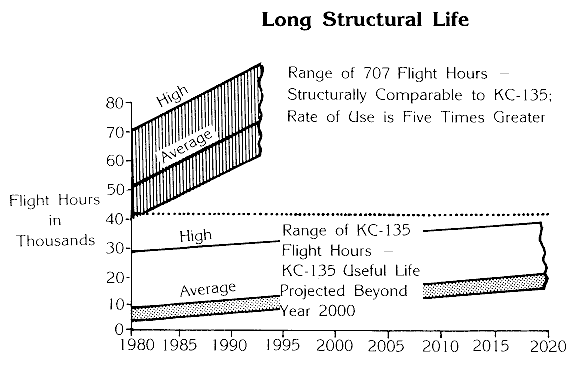
Additional cockpit improvements beyond the PACER CRAG program, would maximize crew efficiency and reduce operation and maintenance costs. With extensive experience in avionics integration, Boeing could offer a new cockpit for the KC-135 that would increase avionics reliability, while allowing the potential for reducing the number of crew members. The newer cockpit would be part of an avionics modernization for the airplane.
The existing cockpit consists of electro-mechanical equipment of 1950s technology with individual control panels and instrumentation distributed throughout. Failure rates are high and repair capability has been restricted significantly as technology has changed. Not only are repairs to the KC-135's existing avionics suite costly for the Air Force, but they also mean more down-time for the tanker while repairs are made. Modem commercial airplane avionics are much more reliable than those aboard the KC-135.
Boeing believes that an avionics modernization program is essential to assure the KC-135 has the technology to perform its mission well in the years ahead. An integrated avionics system would be easier to operate and maintain. The new digital cockpit would include an upgraded multiplex data bus and integration software, integrating global positioning, ground collision avoidance, mission management and inertial navigation systems. Controls would include multi functional electronic displays and centralized control panels.
Specifications |
|
| Primary Function: | Aerial refueling |
| Contractor: | Boeing Military Airplanes |
| Power Plant: | Four CFM-International F108-CF-100 turbofans |
| Thrust: | 22,224 pounds (10,000.8 kilograms) each engine |
| Length: | 136 feet, 3 inches (40.8 meters) |
| Height: | 38 feet, 4 inches (11.5 meters) |
| Wingspan: | 130 feet, 10 inches (39.2 meters) |
| Speed: | Maximum speed at 30,000 feet (9,100 meters) 610 mph (Mach 0.93) |
| Ceiling: | 50,000 feet (15,152 meters) |
| Weight: | 119,231 pounds (53,654 kilograms) empty |
| Maximum Takeoff Weight: | 322,500 pounds (145,125 kilograms) |
| Range: | 11,192 miles (9,732 nautical miles) with 120,000 pounds (54,000 kilograms) of transfer fuel. |
| Crew: | Four or five; up to 80 passengers. |
| Date Deployed: | August 1965. |
| Unit Cost: | KC-135R, $53 million; KC-135E, $30.6 million; KC-135A, $26.1 million. |
| Inventory: | Active force, 457; Reserve, 30; ANG, 158. |
